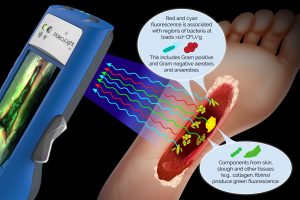See what you’re missing with MolecuLight i:X
The MolecuLight i:X is a handheld fluorescence imaging device that instantly detects wounds containing elevated bacterial loads that may be missed by current standard of care clinical signs and symptoms alone. The MolecuLight i:X emits a precise wavelength of safe violet light, which interacts with the wound tissue and bacteria causing the wound and surrounding skin to emit fluorescence. This fluorescence signal is related to the components of the wounds, including the presence of elevated bacteria loads. Certain bacteria species are well established in the literature to produce porphyrins and pyoverdines that emit red fluorescence. In real-time, MolecuLight i:X captures these red and green fluorescence signals using specialized optical components to filter out the violet light, and displays the resultant image immediately on the display screen (FL-image).1,2 The MolecuLight i:X is precisely calibrated to detect wounds containing bacteria at levels of ≥ 104 CFU/g on a quantitative scale. Bacterial loads in excess of 104 CFU/g typically correspond to those with moderate to heavy growth on a semi-quantitative scale.











